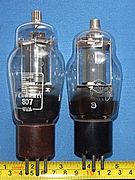Tetrode
A tetrode is a termionic valve made up of four electrodes: cathode, two grids and anode.
History
The tetrode tube was developed by Walter H. Schottky while working for Siemens & Halske GMBH in Germany, during World War I.
The tetrode was developed to avoid an undesirable effect that occurs in the triode tube because the grid and the grid plate behave like a capacitor. This parasitic capacitance feeds back the signal from the plate to the grid, making it difficult for the tube to function properly at high frequencies, so a second grid, called the screen, was introduced between the normal grid and the plate.. With this, the grid-plate capacitor is split into two capacitors in series, decoupling the signal between the plate and the control grid, thus achieving an improvement in the amplification of high frequencies.
A positive potential is applied to the screen in order to accelerate the electrons that go from the filament-cathode to the plate. This "hidden" the anode potential, which has little influence on the control grid. This insensitivity to anode voltage allows much higher gain for a tetrode than for a triode.
Directed beam tetrode
When the power of a thermoionic valve is increased, the electrons reach the anode with increasing energy, until they are capable of removing electrons from the anode itself. These, called "secondary electrons", are directed towards the most positive electrode, so that in triodes or diodes they fall back on the anode, but in a tetrode they are attracted by the screen grid, decreasing the current of anode and valve efficiency. The pentode solves this problem by adding a new grating, but there is another solution: the directed beam tetrode.
In directed beam tubes, tetrodes or pentodes, electrodes connected to the cathode potential confine and direct the electron beam towards the anode, through control and screen grids. These grids consist of two wires wound in a helix with the same pitch so that the wires of the screen grid are located behind those of the control grid, being hidden from the cathode. Thus the electron beam is divided into sheets, which pass between the wires of the control grid and reach the anode. With this arrangement of the grids, the current through the suppressor grid is extremely low. After the suppressor grid there is a space in which the electrons slow down due to the lower anode potential with respect to the screen grid. These slow electrons create a negative space charge that repels the secondary electrons coming from it towards the anode.
The effective action of the space charge for the elimination of the secondary electrons and the reduced screen current provide this type of tube with high power capacity, great sensitivity and efficiency.
Gallery
Contenido relacionado
Second Industrial Revolution
Radiobeacon
Spitzer Space Telescope


